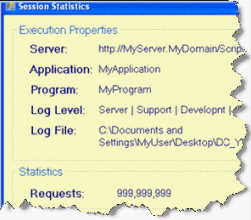[MAGIC_RIA] (Magic xpa 2.x)
The [MAGIC_RIA] section of the Magic.ini file contains the following settings:
|
InternalLogLevel
|
InternalLogLevel=NONE, BASIC, SERVER, SERVER#, SUPPORT, GUI, or DEV
-
NONE: No log
-
BASIC: Only logging of HTTP requests' arrival and departures. This level is meant to be used for troubleshooting of production (and also testing) systems, especially in the areas of communication and component handshaking. Since version: 2.4b
-
SERVER: Only HTTP requests and responses
-
SERVER#: SERVER + the content sent within requests and received within responses. SpecialClientSecureMessages=N should also be set, in order to view unscrambled content.
-
SUPPORT: SERVER + a few messages of .NET, SQLite gateway and data source conversions.
-
GUI: SUPPORT + A few GUI messages logged by the client
-
DEV: All messages logged by the client
Note: The log content is secured and compressed, except for the SUPPORT level log.
During development, the keyword sets the log level of the client. If the InternalLogFile keyword is defined, but InternalLogLevel is left blank, then the log will only include warning and errors.
During deployment, the keyword sets a maximum for the log level of the client.
If the keyword is not set, the maximum log level will be SERVER.
Unlike other server logs that are defined in the Logging section and written to the ExternalLogFileName, the BASIC log level is taken from the [MAGIC_RIA] section and saves the entries to the GeneralErrorLog.
|
|
InternalLogFile
|
InternalLogFile= file name; if not set, the output is directed to the client's desktop: MgxpaRIA_YYYY_MM_DD[.Process ID].log
|
|
InternalLogSync
|
InternalLogSync=Message, Session, or None
-
None: The log file is flushed to the disk automatically, according to the .NET Framework's default.
-
Session: The log file is not flushed to the disk automatically. This level is the fastest.
-
Message: The log file is opened and closed for each message. This level ensures content preserving, but is the slowest.v
|
|
DisplayStatisticInformation
|
DisplayStatisticInformation=Y or N
If set to Y:
Hovering over the rightmost corner of the topmost task's status bar provides a list of the last 5 HTTP requests.
Upon session completion, the client displays the Session Statistics dialog box, and writes the summary to the internal log file.

Platform specific: When using this option on a Windows Mobile device, the Session Statistics will only be written to the log.
|
|
HTTPRequestTimeout
|
This value is sent to the Rich Client during the handshake with the server, and is used to time out HTTP requests from the client to the server (that is, the time that the client will retry sending the request to the server).
If the request cannot be sent to the server, the client will wait for 1/10 of the HTTP request timeout and then resend the request.
Default value: 5 seconds
Since version: 2.4
|
The Studio merges InternalLogLevel, InternalLogFile, InternalLogSync and DisplayStatisticInformation into the execution.properties file in the project's folder, prior to each execution by F7, and spawns the rich client executable (MgxpaRIA.exe) from the folder specified by ClientModulesPath.
The RIA deployment builder does not merge any of these values into either the published HTML (ClickOnce) or the execution properties (mobile).
Note however that these keywords can be set manually for:
-
ClickOnce deployment – in the published HTML or its template:
<Installation folder>\Add_On\Builders\Templates\PublishHtml.tpl
-
RIA mobile deployment – in the execution properties template:
<Installation folder>\Add_On\Builders\Templates\ExecutionProperties.tpl
ClientSessionStatisticsGet

